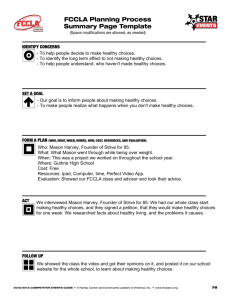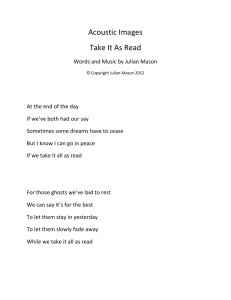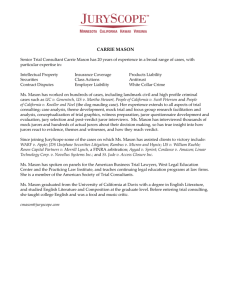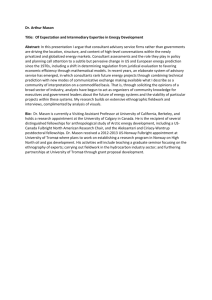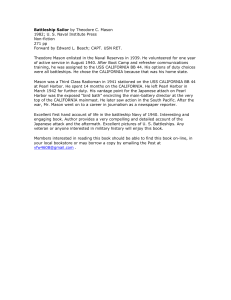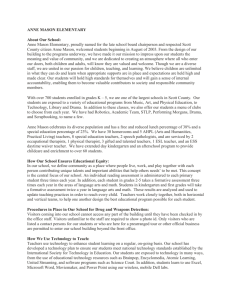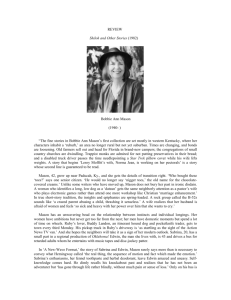Donohue-Wye-Woods
advertisement
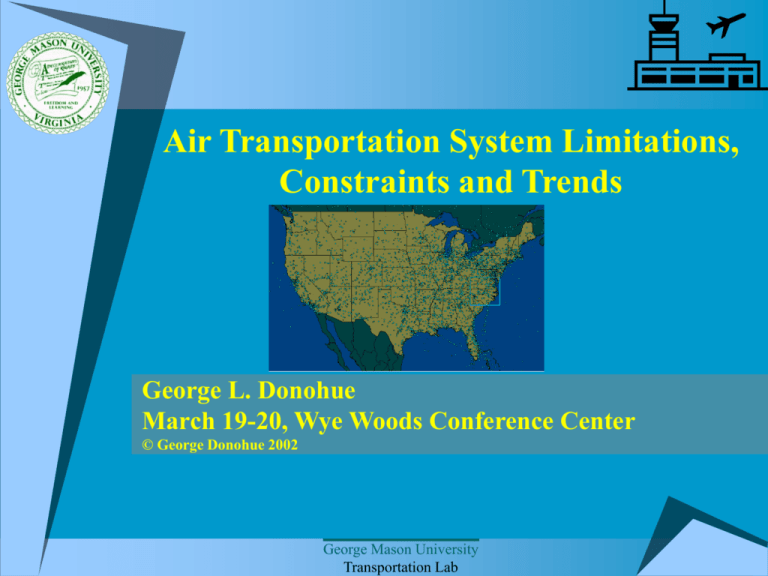
Air Transportation System Limitations,
Constraints and Trends
George L. Donohue
March 19-20, Wye Woods Conference Center
© George Donohue 2002
George Mason University
Transportation Lab
Demand has grown Faster than
National Infrastructure
Relative Growth in Transportation Modes
14.0
Source: DOT Statistics
12.0
Miles / Miles in 1960
10.0
Air
Carrier
Bus
8.0
Truck
6.0
Car
4.0
2.0
0.0
1960
1965
1970
1975
1980
Year
2
George Mason University
1985
1990
1994
Initial Observations
and an Hypothesis
FACTS:
Airspace above Airport Runway Thresholds (Operational
Capacity) is a Limited, Nationally Allocateable Commodity
National Airport and Airspace Management Infrastructure
growth has seriously lagged behind Growth in Air
Transportation Demand
Utilization of this Capacity Commodity is Constrained by
Airline Schedule Conflicts, Delay Tolerance, FAA Ground
Delay Programs and Aircraft Safety (i.e. Aircraft Spacing)
HYPOTHESIS:
A DoT Supervised Auction System may be Required to
Efficiently allocate Airport Capacity within Delay and Safety
constraints
3
George Mason University
Incentives for Operational
Improvements and Modernization
Key Decision Points
DP 1
NATCA Contract Negotiations and Controller
Mass Retirement Threat (Avg. Age=50 +
Service=25) ~2007
Termination of Slot Controls - 2007
Sector Congestion and limits of Radio
Frequency Spectrum Availability ~ 2010
DP 2
DP 3
Transition Barriers
-
-
4
Ground Based Infrastructure
L----M----H
Airborne Equipment
L----M----H
Labor Issues
L----M----H
Regulation
L----M----H
Required Culture Change
L----M----H
Communication Bandwidth
L----M----H
LACK OF INCENTIVES TO CHANGE !!!!
George Mason University
Outline
Limitations on Air Transportation
Capacity
Safety, Capacity and Delay
System Network Effects
Future Security Effects
Observations
Future Vision
5
George Mason University
Operational Capacity is a Limited
Commodity
C
MAX
C
S i (XG)i Ri
{Airports}
–K AK(t) {Airspace Management Intervention}
=2
AR MAX
S = f ( Safety, ATC , Wake Vortex, etc.) ~ 0.6
AK(t) = (A/CREQUEST – A/CACCEPT) ~ [ 0 to >1,000]
AK(t) = f ( GDP:Weather, Sector Workload Constraints )
C AR MAX ~ 64 Arrivals/Hour (set by Runway Occupancy Time)
Ri = Number of Runways at ith Airport
XGi = Airport Configuration Factor at ith Airport
i = 1 to N, where N is approximately 60 Airports
K = 1 to M, where M is typically much less than 100 Sectors
6
George Mason University
Regional Distribution of Airport
Infrastructure is Uneven
TABLE 1 Regional Air Transportation Capacity Fraction For (57) Major Airports
NUMBER
HUB
REGION
NORTH EAST
PACIFIC SOUTHWEST
PACIFIC NORTHWEST
NOTHERN MIDWEST
ATLANTIC COAST
CENTRAL MIDWEST
WEST
SOUTHEAST
FLORIDA & LATIN AM
SOUTH SOUTHWEST
TOTAL
%
Cap97/
Estimated
# A/C TURN Number Ops/Hr
R/W
POINTS
MODEL
1997
14
9
22
42
13
12
22
21
14
27
196
420
262
353
773
269
205
415
424
322
380
3823
348
403
693
1090
438
237
758
776
602
892
6239
294
298
455
684
241
131
405
391
287
433
3620
Avg 8 yr
Growth
CapMAX Rate %
84
74
66
63
55
55
53
50
48
48
58
% NATIONAL TOTAL
9
10
8
32
8
3
9
-2
18
16
11
TAF
1997 ENP
OPERATIONS
X10E6
2012
1997
1,950,000
2,205,000
3,364,000
5,522,000
1,701,000
1,496,000
3,180,000
1,645,786
1,670,280
2,549,603
4,040,088
1,347,458
1,114,207
2,270,307
2,704,000
2,190,557
2,114,000
3,468,000
1,608,673
2,424,105
27,704,000
20,861,064
54
43
62
99
31
19
62
54
48
59
532
89
Donohue and Shaver, TRB 2000
7
George Mason University
78
77
Airport Diseconomies of Scale
Airport Runway Diminishing Returns
XG for Typical Airports
1.20
1.00
0.80
0.60
0.40
XG Factor
Power (XG Factor)
0.20
0.00
0
2
4
RUNWAYS
8
George Mason University
6
8
Non-Linear Network
Characteristics
NAS is a Highly Non-Linear,
EXAMPLE OF AIR TRANSPORTATION SYSTEM NON-LINEARITY
Adaptive System
Controller-in-the-Loop
500
AOC-in-the-Loop
450
3 Airport
Network
at 100
operations
each + 50
operations
increase
SYSTEM CAPACITY (OPS/HR)
400
350
300
250
200
LINEAR SYSTEM
150
NON-LINEAR SYSTEM
100
50
Independent Network
Schedules
Stochastic In Nature
May exhibit Chaotic
Behavior under Some
Conditions
Additive Improvements DO
NOT result in Additive
Increases in NAS Capacity
0
0
100
200
300
400
500
TOTAL AIRPORT CAPACITY (OPS/HR)
9
George Mason University
ie. pFAST, Runways, etc.
Airline Schedule has a Strong Effect on
Network Performance – Model Prediction to
20% Airport Capacity Increase
DPAT Simulation, benchmark capacity, airports ranked by delay extent, with sector
3
2.5
MITRE DPAT
MODEL
Linear System
Response
(min)
2
1.5
1
0.5
Average Arrival Delay
( queue on runway)
Original
LGA
EWR
PHL
BOS
MCO
JFK
PHX
ORD
SLC
TPA
IAD
MIA
DEN
LAS
DCA
LAX
DTW
ATL
MSP
CLT
CVG
SFO
SEA
STL
DFW
IAH
PIT
SAN
BWI
MEM
0
original
1 2 3 4 5 6 7 8 9 10 11 12 13 14 15 16 17 18 19 20 21 22 23 24 25 26 27 28 29 30
10
George Mason University
Outline
Limitations on Air Transportation
Capacity
Safety, Capacity and Delay
System Network Effects
Future Security Effects
Observations
Future Vision
11
George Mason University
Capacity vs. Delay Penalty
Delay
600
Delay
IAD
400
25
200
20
0
15
Departure_Rate
5
10
10
15
5
Arrival_Rate
20
Arrivals
[3] “ACE 1999 Plan,” CD-ROM. Federal Aviation
Administration – Office of system capacity.
12
George Mason University
25
Depart
NY LaGuardia: A non-Hub
Maximum Capacity Airport
1 Arrival Runway
1 Departure Runway
45 Arrivals/Hr (Max)
80 Seconds Between Arrivals
11.3 minute Average Delay
77 Delays/1000 Operations
40 min./Delay
13
George Mason University
New York LaGuardia Airport
Arrival- Departure Spacing VMC
60
ASPM - Apr 2000 - Visual Approaches
ASPM - Oct 2000 - Visual Approaches
Calculated VMC Capacity
50
Arrivals per Hour
Optimum Rate (LGA)
40
40,40
Each dot represents one
hour of actual traffic
during April or October
2000
30
20
45 Arr./Hr/RW
@ 80 sec
separation
10
0
0
10
20
30
40
50
60
Departures per Hour
14
George Mason University
DoT/FAA
Atlanta: A Maximum Capacity
Fortress Hub Airport
2 Runways – Arrivals
2 Runways – Departures
50 Arrivals/Hr/RW – Max
72 Seconds Between Arrivals
8.5 minutes Average Delay
36 Delays/1000 Operations
38 min./delay
15
George Mason University
Atlanta Airport
Arrival-Departure Spacing VMC
ASPM - April 2000 - Visual Approaches
120
Calculated VMC Capacity
100,100
Optimum Rate (ATL)
Arrivals per Hour
100
80
60
Each dot represents one
hour of actual traffic
during April 2000
40
20
50 Arr/Hr/Rw
0
0
20
40
60
80
100
Departures per Hour
120
@72 sec
Separation
DoT/FAA
16
George Mason University
Major US Airport Congestion
LAX
ATL
STL
ORD
SEA
MSP
AIRPORT
LGA
SFO
PHL
EWR
IAD
DTW
DFW
Queuing Delays
Grow Rapidly
CLT
PIT
JFK
J. D. Welch and R.T.
Lloyd, ATM 2001
BWI
DEN
0
0.1
0.2
0.3
0.4
0.5
0.6
DEMAND / CAPACITY RATIO
17
George Mason University
0.7
0.8
0.9
Aircraft Arrival Rate:
Distance-Time Relationship
Spacing
80
(sec)
ARRIVALS / RW / HR
70
120 Knots
60
60
130 Knots
72
50
140 Knots
40
90
30
120
20
180
10
0
0
1
2
3
4
DISTANCE ( NMi)
18
George Mason University
5
6
7
LGA Aircraft Inter-Arrival
Time Distribution
LGA Arrival Seperation Histogram
35
μ = 134 sec., σ = 73 sec.
Number of Aircraft in 20 Sec. Bins
30
LGA VMC
70
sec
25
20
CAPACITY
SAFETY
15
96 Sec. WV
Separation
Expected Value
10
5
0
0
50
100
150
200
250
-5
Aircraft Inter-Arrival Time (seconds)
19
George Mason University
300
350
Possible Relationship Between Safety and
Capacity: ATM Technology Effect
Hypothesis: SAFETY-CAPACITY SUBSTITUTION CURVES
U.S. MILLION DEPARTURES/YEAR
140.00
15 HULL LOSS/YR
5 HULL LOSS/YR
2 HULL LOSS/YR
S-C @ CURRENT TECH.
S-C @ REDUCED SEP.
120.00
100.00
80.00
60.00
US
40.00
20.00
0.00
2.00
4.00
6.00
8.00
MILLION DEPARTURES/HULL LOSS
20
George Mason University
10.00
12.00
Outline
Limitations on Air Transportation
Capacity
Safety, Capacity and Delay
System Network Effects
Future Security Effects
Observations
Future Vision
21
George Mason University
The Semi-Regulated Market Does Not Act
to Minimize Delay: LGA Air 21 Impact
LaGuardia Airport
200
180
160
140
120
100
80
60
40
20
0
Maximum Hourly
Operations Based on
Current Airspace &
ATC Design
06 07 08 09 10 11 12 13 14 15 16 17 18 19 20 21 22 23
Time of Day
Historic Movements
AIR-21 Induced Svc.
Source: William DeCota, Port Authority of New York
22
George Mason University
Annual and Seasonal Delay Trends
(Note Possible Effect of Air 21 on LGA & System)
OPSNET Total System Delays
60
Thousands of Delays
50
2000
1999
1998
1997
1996
1995
40
30
20
10
Month
23
George Mason University
C
E
D
N
O
V
T
C
O
P
E
S
A
U
G
L
JU
N
JU
Y
M
A
R
P
A
M
A
R
B
FE
JA
N
0
Outline
Limitations on Air Transportation
Capacity
Safety, Capacity and Delay
System Network Effects
Future Security Effects
Observations
Future Vision
24
George Mason University
Observations
Approximately 10 of the Top US Hub Airports are
Operating close to Maximum Safe Capacity
Demand / Capacity Ratio’s Greater than 0.7 lead to Very
Rapid Increase in Arrival and Departure Delays
Higher Delays Lead to Loss of Schedule Integrity
25 New Runways Not a Solution
Airline Hub and Spoke Network System Produces a
Highly Non-Linear, Connected System
Weather, Security or Terminal Delays Propagate
System Wide
Airline Schedules are part of the Problem & Solution
ATC Sector Controller Workloads and Weather also
Produce Network Choke-Points that Produce Capacity
Constraints
25
George Mason University
Observations (cont.)
100% EDS Baggage Screening will either Increase
Delays or Travel Block Times for Commercial Ops
Current Regulations on Airlines and Airports do
not provide Incentives for either Safe or Efficient
Operations
Airlines are over-scheduling Major Airports
ATC is spacing Aircraft at the limits of current technology
leading to growing safety concerns
Airlines are moving to Smaller aircraft to increase
frequency of operations and profitability, leading to
increased congestion and delays
Airlines are resisting modernizing their aircraft with the
technology required to decrease spacing and increase
capacity
Incentives are to be last to equip
26
George Mason University
Outline
Limitations on Air Transportation
Capacity
Safety, Capacity and Delay
System Network Effects
Future Security Effects
Observations
Future Vision
27
George Mason University
Vision: Incentives for Operational
Improvements and Modernization
Brief Summary of Vision:
Major Hub Airports will Allocate Slots by DoT Auctions:
-Both Strategic, Near Term and Spot Auctions
-Peak runway loading will be reduced to Government Established
Safety and Capacity optimized schedules
-Aircraft Size will be driven by a combination of airline profits
and maximum enplanement opportunities
Business travel will migrate to Travel on Demand via air-taxi or
private aircraft ownership and operation
Increased En-route Traffic density will be accommodated by
Aircraft Self Separation-Technology-Equipped Flight Corridors
Auctions will provide incentives for aircraft technology insertion
and a government contract to provide enhanced benefits
28
George Donohue
George Mason University
Outline
Limitations on Air Transportation
Capacity
Safety, Capacity and Delay
System Network Effects
Future Security Effects
Observations
Future Vision
29
George Mason University
Key Airport System Flows
MIT Queuing Model
Entry
Fix
Passengers
Arrivals
Pax
Screen
Arrival
Paths
Runways
Dept.
Paths
Taxiways
Departures
Ramp
Check-In
ID
Gates
Ckd Bag
Screen
Bags/Cargo
Departure
Fix
Airside
30
Groundside
George Mason University
Gnd
Trans
Drop-off
Parking
Baggage: Actual and Spread Demand
for 1998 DFW Case (RAND Study)
Number of Check-In Bags per 3-Minute
Increment
1000
Scheduled Demand, No Spread
Demand Spread = 30 mins (flat)
900
Total Check-In
Bags = 56,516
800
700
600
500
400
300
200
100
0
6
7
8
9
10
11
12
13
14
15
16
17
Time of Day
Dr. R. Shaver
31
George Mason University
18
Planned Time of Arrival According to
Passenger Propensity to Accept Risk
“The Passenger’s View”
Planned Time of Arrival Before Scheduled
Departure--Includes 15 minute Unplanned
Delay Before Baggage Check-In (minutes)
120
105
90
75
60
45
30
15
0
100.0%
R. Shaver, RAND
32
Machines
Machines
Machines
Machines
Machines
Machines
10.0%
Deployed
Deployed
Deployed
Deployed
Deployed
Deployed
1.0%
Probability that Bag Misses Plane
George Mason University
=
=
=
=
=
=
[17:24]
[19:28]
[20:29]
[22:32]
[24:34]
[15:22]
0.1%
